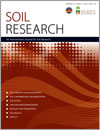SR15185Soil phosphorus status and environmental risk of phosphorus run-off from pastures in south-eastern New South Wales
Representative grassland soils in south east NSW were sampled to provide an overview of agronomic phosphorus requirement and phosphorus environmental risk for pastoral land uses. From soil Colwell P and phosphorus buffering index (PBI) values, 20% of the sites was considered to present a significant environmental risk to water quality. Routine use of soil PBI analysis with Colwell P tests could improve land management practices to reduce diffuse pollution from agriculture.




